
Topics
Guests
- Steve Robinsonexecutive director, National Gulf War Resource Center. They monitor the current status of scientific studies.
- Dr. Asaf Durakovicnuclear scientist and former chief of the Nuclear Sciences Division at the Armed Forces Radiobiology Research Institute. He is currently the medical director of the Uranium Medical Research Center, an independent nonprofit institute which studies the effects of uranium contamination.
- Christopher Busbyscientific secretary with the European Committee on Radiation Risk, a group of scientists and risk specialists within Europe who assess the risk levels of low-level radiation exposure. The ECRR has just published a report which determines that previous risk models for depleted uranium exposure are incorrect. The report determines that depleted uranium is 100 to 1,000 times more carcinogenic than the present risk model suggests. Dr. Busby is also a member of the International Society for Environment Epidemiology and was invited to Iraq and Kosovo to investigate the health effects of depleted uranium. He has also given presentations on depleted uranium to the Royal Society and to the European Parliament. He is a member of the U.K. Ministry of Defense Oversight Committee on Depleted Uranium.
- Karen Parkerattorney specializing in humanitarian law. She has been working with the U.N. Commission on Human Rights since 1996 to expose the illegality of DU munitions under humanitarian law.
As the Pentagon weighs deploying nuclear weapons in Iraq, we’re going to take a look now at another kind of radioactive weapon U.S. troops may use: depleted uranium.
Depleted uranium is the most effective anti-tank weapon ever devised. It is made from nuclear waste left over from making nuclear weapons and fuel. As an unwanted waste product of the atomic energy industry, it is extremely cheap. It is also the densest material available on the market and can smash through all known armor. U.S. gunners say DU rounds save lives on the frontline.
But when DU rounds punch through tanks, they create a firestorm of uranium dioxide dust. Those invisible particles are still “hot.” As The Christian Science Monitor’s Scott Peterson writes, the particles make Geiger counters sing. They stick to the tanks, contaminate the soil and blow in the desert wind — as they will for the 4.5 billion years it takes for the DU to lose its radioactivity.
The public first became aware the U.S. military was using DU weapons during the 1991 Gulf War. U.S. gunners used 320 tons of DU to destroy 4,000 Iraqi armored vehicles.
The Pentagon deemed those vehicles a “substantial risk,” and U.S. forces buried them in Saudi Arabia and low-level radioactive waste dumps in the U.S. Thousands of U.S. troops became sick after that war, afflicted with a range of mysterious symptoms that have come to be known as Gulf War syndrome. Many vets believe DU is responsible. According to Reuters, some troops are so concerned about a new Gulf War syndrome, they have begun to bank their sperm before they head to the Middle East. The sperm banks are now offering discounts to troops.
Iraqis say DU is a major cause of the severe health problems such as cancer and birth defects. The director of the cancer ward at Basra’s Saddam Teaching Hospital says pre-war cancer rates have increased 11 times.
The Pentagon and the White House deny this. Pentagon officials refer to the latest government report on the subject, which said, “Gulf War exposures to depleted uranium have not to date produced any observable adverse health effects attributable to DU’s chemical toxicity or low-level radiation.” Just last week, the White House Office of Global Communications rolled out a new propaganda document called “Apparatus of Lies: Saddam’s Disinformation and Propaganda 1990-2003.” The document characterized Iraq’s claims as a campaign of disinformation.
Despite repeated calls, the Pentagon refused to be interviewed for this program.
In a minute, we’ll be speaking with Dr. Asaf Duraković. In 1991, Dr. Duraković was chief of nuclear medicine at the veterans’ hospital in Wilmington, Delaware. There he discovered the first Gulf War veterans with symptoms of radiation exposure. The hospital terminated him after he refused to halt his research. He has pursued the research to this day. He was also a former U.S. Army colonel. He rarely gives interviews in this country. But first we go to Steve Robinson of the National Gulf War Resource Center.
The UMRC recently sent a team to the Nangarhar province in Afghanistan to test for uranium contamination in residents living near and around U.S. bombing sites during Operation Enduring Freedom.
Transcript
AMY GOODMAN: You are listening to Democracy Now!, Breaking the Sound Barrier. I’m Amy Goodman.
Sperm banks across the country are heeding the call of patriotism and offering U.S. servicemen faced with fighting a possible war in Iraq the chance to leave a little of themselves behind for free or at a deep discount. California Cryobank, one of the nation’s largest sperm banks, said on Wednesday that more than 40 military personnel had taken up a one year’s free sperm storage offer as a precaution against the possibly harmful effects of vaccine or chemical weapons exposure, like depleted uranium, on their fertility.
Well, today we’re going to talk about depleted uranium, as the Pentagon weighs deploying nuclear weapons in Iraq. We’re going to look at this other kind of radioactive weapon that U.S. troops may use. Depleted uranium is the most effective anti-tank weapon ever devised. It’s made from nuclear waste left over from the making of nuclear weapons and fuel. As an unwanted waste product of the atomic energy industry, it’s extremely cheap. It’s also the densest material available on the market and can smash through all known armor. U.S. gunners say DU rounds save lives on the frontline.
But when DU rounds punch through enemy tanks, they create a firestorm of uranium dioxide dust. Those invisible particles are still hot. As The Christian Science Monitor’s Scott Peterson writes, the particles make Geiger counters sing. They stick to the tanks, contaminate the soil and blow in the desert wind, as they will for the four-and-a-half billion years it takes for the DU to lose its radioactivity.
The U.S. military introduced DU weapons to the world for the first time in the ’91 Gulf War, U.S. gunners used 320 tons of DU to destroy 4,000 Iraqi armored vehicles. The Pentagon deemed those vehicles a, quote, “substantial risk,” and U.S. forces buried them in Saudi Arabia and low-level radioactive waste dumps in the U.S.
Thousands of U.S. troops became sick after that war, afflicted with a range of mysterious symptoms that have come to be known as Gulf War syndrome. Many vets believe that depleted uranium is responsible. According to Reuters, some troops are so concerned about a new Gulf War syndrome, they’ve begun to bank their sperm, as we said, before heading to the Middle East.
Iraqis say DU is a major cause of the severe health problems such as cancer and birth defects in Iraq. The director of the cancer ward at Basra’s Saddam Teaching Hospital says pre-war cancer rates have increased 11 times. The Pentagon and the White House deny this. Pentagon officials refer to the latest government report on the subject, which said, “Gulf War exposures to depleted uranium have not to date produced any observable adverse health effects attributable to DU’s chemical toxicity or low-level radiation.” Just last week, the White House Office of Global Communications rolled out a new propaganda document called “Apparatus of Lies: Saddam’s Disinformation and Propaganda 1990-2003.” The document characterized Iraq’s claims as a campaign of disinformation.
We’re going to start off the segment by briefly talking to Steve Robinson. We did place numerous calls to the Pentagon, but they refuse to be interviewed. Steve Robinson is executive director of the National Gulf War Resource Center, which monitors the current status of scientific studies.
Very briefly, Steve, can you just tell us how many Gulf War vets you believe have been affected by depleted uranium?
STEVE ROBINSON: Sure. Actually, there’s a — we maintain a lot of different numbers, where we can get them. Right now, as we understand it, about 400,000 were exposed to depleted uranium, about 250,000 took the experimental vaccinations and pills, and about 140,000 were exposed to chemical warfare agent during the war.
AMY GOODMAN: And how do you know this? How are you doing these counts?
STEVE ROBINSON: How do we get the numbers?
AMY GOODMAN: Yes.
STEVE ROBINSON: These numbers are estimates given by the Pentagon.
AMY GOODMAN: And how do you know that depleted uranium is playing a role? I mean, vets have been exposed to so much.
STEVE ROBINSON: Well, for my organization, we look at depleted uranium as an unanswered question. And the question is: Can DU cause long-term health effects? Now, there have been many scientific studies that are starting to come out that show that in laboratory analysis, laboratory animals, DU ingested and inhaled can cause cancers. We’ve got United Kingdom soldiers who have depleted uranium in their body serum. And those soldiers are starting to have systemic problems with their different body organs. And we’ve also got the reports that are coming out of Iraq, which you have to view with a skeptical eye. But I don’t think the question is answered yet. So, in my mind, and for our organization, we know that DU is harmful, because we’ve got science that says that it is. The real big question is: Is it the thing that caused Gulf War illnesses? I think it’s part of it. But I think there are also other exposures along with depleted uranium that made veterans sick.
AMY GOODMAN: Well, Steve Robinson, I want to thank you very much for being with us, executive director of the National Gulf War Resource Center.
We’re now going to turn to Dr. Asaf Duraković, who is a nuclear scientist and was the chief of Nuclear Sciences Division at the Armed Forces Radiobiology Research Institute at the VA hospital in Wilmington, Delaware, where he discovered the first Gulf War veterans with symptoms of radiation exposure. He’s been blacklisted in the United States for exposing the depleted uranium link to Gulf War syndrome. Again, a former U.S. Army colonel.
Welcome to Democracy Now!
DR. ASAF DURAKOVIĆ: Thank you.
AMY GOODMAN: It’s good to have you with us. Can you talk about first how you got involved with this research, how it is that you first decided to test Gulf War veterans who were complaining of feeling ill, to test them for radiation exposure?
DR. ASAF DURAKOVIĆ: Before I start, I would like to state that I am a Gulf veteran myself. In the month of August 1991, Ventnor Clinic of New Jersey refers to meet 24 United States soldiers who suffered from symptomatology that they could not understand. I examined those patients at the Nuclear Medicine Clinic of the VA hospital in Wilmington. And by taking patients’ histories and symptoms, I concluded that they could have been contaminated internally by some radioactive isotopes. At that time, it was very well known to me that depleted uranium was detected in the tanks that were being buried in the sands of Saudi Arabia by Dr. Doug Rokke.
I sent the samples of urines of those patients to Army Radiochemistry Laboratory in Aberdeen, Maryland, and they simply disappeared. For many months, we had no evidence what happened to those samples. Later on, there were several theories that they were negative, they disappeared, the post office did not deliver them. So it was total obscurity of it. I continued my work for several years, and I encountered considerable resistance from the government about continuation of my research. I was asked to stop my work, which I refused, saying that I was hired by the government of the United States to protect and heal and cure the veterans who are referred to me. So I continued my work. And every —
AMY GOODMAN: Can you explain why the — can you — can you explain why the government and the military hospital was telling you to stop?
DR. ASAF DURAKOVIĆ: Well, management of the hospital itself, including director, including chief of staff, including several telephone calls from every conceivable level of the government of the United States, even some of my former colleagues, who worked with me on active duty in the different military [inaudible], were calling me from different parts of the country, asking me to stop that research, which I plainly and adamantly refused, because I was hired by the government of the United States to take care of the people who were under my jurisdiction, my patients who were treated and studied in the internal — in the Nuclear Medicine Clinic of my hospital.
AMY GOODMAN: And so, with the hospital wanting you to stop, and you refusing to do that, what happened?
DR. ASAF DURAKOVIĆ: Yes, yes. The hospital management showed not only resistance, but also open hostility. When I organized a meeting between a military and the VA officials to study or to implement radioactive response team in the VA hospital, it was directly and straightforwardly objected by the director of the hospital, who told me that I cannot continue that work.
AMY GOODMAN: And so, at what point did you part ways?
DR. ASAF DURAKOVIĆ: I beg your pardon?
AMY GOODMAN: At what point did you part ways with the hospital?
DR. ASAF DURAKOVIĆ: What point?
AMY GOODMAN: At what point did you leave?
DR. ASAF DURAKOVIĆ: We have unclear connection. I’m very sorry.
AMY GOODMAN: At what point did you leave the hospital, were you forced out?
DR. ASAF DURAKOVIĆ: Oh, I was terminated after 18 years of honorable service in the government of the United States, including 14 years of active duty with the rank of colonel. I simply was terminated in the year 1998. My job was terminated. And I was the only government nuclear medicine specialist in the state of Delaware. Therefore, my presence in that hospital was absolutely essential. As soon as I left, they hired another full-time person to replace me.
AMY GOODMAN: I’m looking at a piece in The Sunday Times of London that appeared two years ago, and it says, “A scientist’s theory about why soldiers are ill is so contentious that the authorities want to silence him. Nine years of obsessively pursuing research that could have huge implications for Britain and America have taken their toll on Dr. Asaf Duraković. As he looked out over a packed auditorium, he railed against the government conspiracy that prevented his paper being highlighted as one of the best at the European Conference of Nuclear Medicine last week. Afterwards, the truculent 60-year-old tells me, ’It’s a miracle they accepted the presentation in the first place.’” And yet they did, and you are seen by many as one of the foremost medical doctors and scientists working internationally in the field of nuclear and radiation medicine. After you left the U.S. government and military hospital’s employ, how did you continue your work, and what have you found in regards to depleted uranium? And then we’re going to talk about your latest research, as well.
DR. ASAF DURAKOVIĆ: I wrote a letter to President of the United States Bill Clinton stating that, in my opinion, resistance about my work in dealing with the sick Gulf War veterans constitutes nothing else but conspiracy against the veterans of the United States. I was motivated by the patriotic motives to help those unfortunate soldiers who sacrificed their health and their lives in the battlefields in the desert of Iraq. After I was terminated in the VA Hospital, I decided to continue my work, because many of those soldiers were dependent on me, and I started with them before I was terminated in my position. The duty of the medical doctor is never to abandon his patients. It was not my intention to ever abandon the people who were entrusted to me by the government of the United States to study, diagnose and treat them. My ethical responsibility and my patriotic responsibility to this country included my moral duty to continue that work.
As all doors were closed to me in the government hospitals, I started our own institute, which is currently called Uranium Medical Research Center. We continued to work with the patients who were veterans from Great Britain, Canada and the United States. And we analyzed their samples in nongovernmental laboratories. We found that over 60% of the patients referred to us contained depleted uranium in their bodies. This study has been published in the United States journal of Military Medicine last year, and another study is going to be published in the month of June of the current year. The work continues, not only with the remaining population of the veterans of the allied forces, but also with the population of Afghanistan or any population that, in our opinion, is exposed to uranium and transuranic elements, because this is a field of my specialty, my medical expertise and 30 years of intense research in the medical and biological effects of internally deposited radioactivity.
AMY GOODMAN: If soldiers are getting sick because of exposure to depleted uranium, what can they do? What do you believe is the treatment?
DR. ASAF DURAKOVIĆ: Medical facilities of the entire world of today, with all sophistication that has been developed after Korean War, Vietnam War, and experiences in the different data fields, are not capable of dealing with the mass casualties caused by the radioactive and nuclear weapons. Radioactivity internally deposited in the bodies of the people who inhaled radioactive dust containing depleted uranium or nondepleted uranium are such that no medical facility of the world can handle more than maybe couple of dozen patients at a time. We know from the experience of the research and the practical cases of the wars, that some of the irradiated patients, either outside or inside irradiated, can be treated. But we are talking about millions of potential victims in the event of the mass use of nuclear or radioactive weapons.
As a medical doctor and a scientist, I have to make a statement that medicine of today is not capable to provide the care for the mass casualties that are anticipated in the uncontrolled use of nuclear weapons. Even if the weapons are used in the limited fashion, like concentrated on the city of Baghdad or Basra or any other city of the world, we are dealing with unforeseeable consequences, which will not only affect the current generation, but many generations later. We have evidence in our own patients who have been studied by the spectrometry analysis, that their cells contained chromosomal damage and mutations, which was done in one of the laboratories in Germany. So there is no doubt that depleted uranium present in the body of American, Canadian and British soldiers did already cause genetic mutations that are going to follow for many generations to come.
AMY GOODMAN: Dr. Duraković, we have to break for 60 seconds. I also just want to stress to our listeners and viewers, this is a very rare interview that Dr. Duraković is doing. We also are going to talk about what his very preliminary findings have been in looking at what has been used in Iraq — rather, in Afghanistan. And we’re going to talk about that when we come back. Stay with us.
[break]
AMY GOODMAN: You are listening to Democracy Now!, The War and Peace Report, The Exception to the Rulers. I’m Amy Goodman. We are talking to Dr. Asaf Duraković, a nuclear scientist who was the chief of the Nuclear Sciences Division at the Armed Forces Radiobiology Research Institute, currently medical director of his own center, the Uranium Medical Research Center, which is an independent nonprofit that studies the effect of uranium contamination. Your group recently sent a team to Afghanistan. Now we’re going to talk not about depleted uranium, or, though, you can tell us if you found evidence of depleted uranium used in Afghanistan. We know it was used in Kosovo. The military was loath to admit this; it took them months. We know it has been used in Vieques, the same thing. It takes them years to admit that they use it, and then when they’re finally forced to, they say it does not have medical effects and that it is harmful in terms of radioactivity. Now you’re looking at some other — you’re looking at things other than depleted uranium in Afghanistan. Can you explain?
DR. ASAF DURAKOVIĆ: Well, we are talking not about political propaganda. We are talking about mathematical certainties. Mathematical certainty is that uranium isotopes, three of them being natural isotopes, do have capacity of causing somatic and genetic damage to the exposed people. This knowledge is not recent. We know it for 200 years, since the times of Dr. Gmelin at the University of Tübingen in Germany sometimes the odd 200 years ago. At that time, radioactivity was not known. Dr. Gmelin talked about most dangerous of all chemical substances that he studied being uranium isotopes. Now, 100 years later, at the end of the 19th century, when Dr. Becquerel discovered radioactivity in uranium, the era of nuclear time started dawning on the world. From that time, it was very well known that uranium isotopes do have capacity of causing malignant diseases, cancers, leukemia. And the scientists who were involved in that research, including Madame Marie Curie, including her daughter Irène, and the generations of scientists after them died of the illnesses that were undoubtedly caused by the isotopes of uranium. Uranium isotopes, whether depleted or nondepleted, do have capacity of irradiating most radio-sensitive cells in the body. And lucky cells are those who are dead. Unlucky cells are the ones which develop mutations and carcinogenic properties.
AMY GOODMAN: Can you explain the difference —
DR. ASAF DURAKOVIĆ: Now, there are many skeptics —
AMY GOODMAN: Can you explain the difference between depleted uranium and uranium, and why the military would use one or the other?
DR. ASAF DURAKOVIĆ: Well, depleted uranium is, as someone said before, very inexpensive, and it is a waste product of the enrichment process of uranium for the development of nuclear weapons or the rods for the use in the nuclear reactors. The only difference between nondepleted and depleted uranium is percentage of uranium-235, which is lower in depleted uranium. Now, because it is cheap and because it is very dense, having mass 1.7 times higher than lead, it has capacity to penetrate through any armor with high degree of efficiency. But side effect is release of radioactivity in the air in the form of radioaerosols, which people inhale. And by the inhalation, they get access into the bloodstream, reaching the most radiosensitive cell populations in the body, including bone marrow, including cells of the intestine —
AMY GOODMAN: Now, this is an important —
DR. ASAF DURAKOVIĆ: — including [inaudible] system —
AMY GOODMAN: Dr. Duraković, this is an important point you’re saying, when you inhale it, because the Pentagon says that depleted uranium, for example, is not harmful to your health, saying that the danger is minor to minimal because alpha particles can’t penetrate clothes and skin. That’s different from inhaling it.
DR. ASAF DURAKOVIĆ: I am sure people of Pentagon whom you mention are not scientists. And anyone who is nonscientist can take a chance of irresponsible statement. Pentagon spokesmen whom you quoted are definitely entirely wrong, because alpha particles indeed are harmless if they are applied to the surface of the body, alpha particles can hardly penetrate the thickness of the skin or a simple sheet of paper, but we are not talking about skin. Skin is not radiosensitive tissue of the body. We are talking about internal circulation of uranium isotopes who are alpha emitters and in the vicinity of the cells, which are highly sensitive to radiation. They can cause carcinogenic modifications of those cells and mutations that will cause subsequent effects that are disastrous for populations of the cells that have been exposed.
Uranium contains alpha and beta and some gamma radiation. And alpha radiation is highly positively charged alpha particles. When they go through the tissue, they pull negatively charged electrons from the external shells of the atoms, making those atoms disintegrate and lose their structures, lose their place in the molecular binding, and tissue undergoes either death or modifications that are absolutely and undoubtedly harmful. And we are not talking about propaganda of anti-government or government circles. We are talking about objective, true, mathematical certainty, what will happen to the radiosensitive cells, which do get in touch or in contact with the alpha particles of uranium isotopes.
AMY GOODMAN: Dr. Duraković, can you talk about what is the evidence of the use of depleted uranium or other uranium weapons in Afghanistan? What have you found?
DR. ASAF DURAKOVIĆ: Our institute sent two teams for the field investigations of the uranium presence in Jalalabad, Mazar-i-Sharif, Kabul, Tora Bora and several other places in Afghanistan. Our members of the team brought several dozen samples of the water and soil from the craters and outside of the craters where the bombs fell. They also took biological specimens of Afghan civilians, particularly urines, and some of our samples have been analyzed so far. The other samples are waiting for analysis in very updated spectrometry laboratory in England.
Our findings show that there is considerable presence of uranium isotopes in the urine of the civilians who present medically with a similar symptomatology as it was encountered in the Gulf War in 1991. Those samples astonished us, and we didn’t actually believe them in the beginning, when we received the numbers from the laboratories, because they simply defied any wildest imagination that we had on the basis of theoretical understanding of uranium in the human body. The concentration of uranium in the sick Afghan civilians was 100 to 400 times higher than in the normal controls. And our normal controls were absolutely nonexposed people from England and from some other places which have absolutely no exposure to any kind of isotopes of uranium. We asked scientists who are experts in geology to try to interpret these samples for us by any statement that may lead us to better understanding of the high level of uranium in those human beings.
AMY GOODMAN: You know, Dr. —
DR. ASAF DURAKOVIĆ: And geologists —
AMY GOODMAN: Go ahead.
DR. ASAF DURAKOVIĆ: Geologists failed to understand it, as well, because geological formation of the land in Afghanistan which was studied does not reveal any particularly high deposits of uranium before the bombing raids.
AMY GOODMAN: Dr. Duraković, the UNEP, the United Nations Environment Program, just came out with a post-conflict assessment of environmental impact in Afghanistan following the U.S. bombing. It’s very interesting, because it — yeah, it’s very devastating on other issues, saying that the conflict has brought about a collapse of local and national governments, destroyed infrastructure, hindered agricultural activity and has caused massive problems. But when we asked Pekka Haavisto, chair of the task force that did this report on the devastating environment in Afghanistan, he said they did not test for depleted uranium, because the Afghan government didn’t ask them to test, and they do what the governments ask for, the U.S.-backed Afghan government.
But right now we’re joined on the telephone by Dr. Chris Busby. He has just put out a new report that raises the level of risk for people exposed to DU munitions — that looks at the levels of risk of people exposed to DU munitions. We’ve just reached him on a train. He gave the report in Brussels. He’s headed to London. Can you, very briefly, Dr. Busby, in the last minute that we have left, tell us the results of your report?
CHRISTOPHER BUSBY: Hello?
AMY GOODMAN: Yes. Can you tell us the results of your report, Dr. Busby, very briefly?
CHRISTOPHER BUSBY: Yes. The report argues or develops a new model, which shows that the risk from internal radiation from particles, like depleted uranium particles, is between 100 and 1,000 times greater.
AMY GOODMAN: Are you there? We’ll try to get him on. But, Dr. Asaf Duraković, you’ve heard just the preliminary words of Dr. Chris Busby. Your response?
DR. ASAF DURAKOVIĆ: My response is very simple. Chris Busby is an outstanding scientist with impeccable record in the low-level radiation, and his statements have to be taken with absolute seriousness. He is totally correct in his statement that we just heard. We are dealing with probability of unforeseeable environmental catastrophe in Afghanistan, not only in the biosphere, contamination of the food chain, but also in the civilian population. And again, it is not hypothesis. It is a fact that has been proven by many independent scientific studies.
AMY GOODMAN: Dr. Duraković, we just got Dr. Busby back on, who’s on that train from Brussels to London. Can you finish the sentence?
CHRISTOPHER BUSBY: Hello. Are you there?
AMY GOODMAN: Yes, we’re there. Go ahead.
CHRISTOPHER BUSBY: I’ll just finish what I was saying, that this report underpins the idea that these materials are up to a thousand times more dangerous than is presently believed on the basis of the ICRP and United Nations risk models. And so we’re quite, quite capable of understanding that there are increases in ill health in people in places like Iraq and Kosovo, and also in the veterans who are exposed to these materials, because they operate from inside the body and cause very large amounts of damage to cells, which are local to the particles.
AMY GOODMAN: I want to bring one last person in in this last minute, and it is Karen Parker, attorney in humanitarian law, who’s been working with the U.N. Commission on Human Rights since 1996, around depleted uranium. Is it legal under international law, Karen Parker?
KAREN PARKER: Hello. No, it is not legal. It’s difficult for people to understand why it’s illegal, because there is no treaty. But weapons have to be evaluated prior to their use. Based on the existing rules in humanitarian law, weapons have to be shown that they can be contained within the territory of the field of battle. They have to be capable of being controlled and eliminated when the war is over. They have to be humane. In other words, the way they kill can’t be by lingering illnesses and gene destruction and cancer-causing. And they can’t unduly harm the environment. Depleted uranium and some of the other uranium or radiological weapons we are using can’t pass that test.
AMY GOODMAN: On that note, I want to thank everyone for being with us. This is an ongoing discussion. Again, the Pentagon denies the ill effects of depleted uranium. I want to thank Karen Parker. I want to thank Dr. Asaf Duraković for agreeing to this interview, and Dr. Chris Busby, who’s just released his report with the European Committee on Radiation Risk. He’s the scientific secretary, a group of scientists and risk specialists within Europe who assess the risk of low-level radiation exposure. You can go to our website, democracynow.org. You can get a copy of today’s show by calling 1-800-881-2359, 1-800-881-2359. Democracy Now! produced by Kris Abrams, Mike Burke, Angie Karran, Ana Nogueira, Alex Wolfe; Mike Di Filippo, our engineer. I’m Amy Goodman. Thanks for listening.

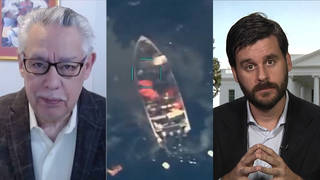
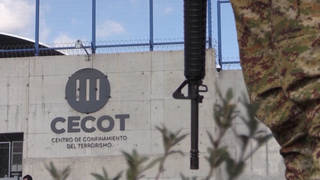
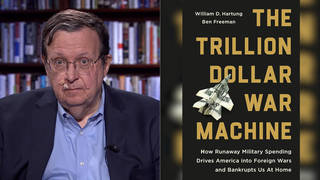
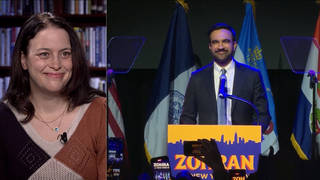





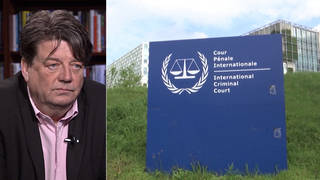
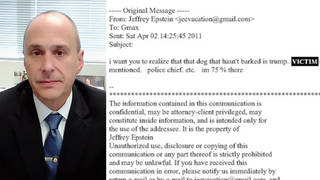
Media Options